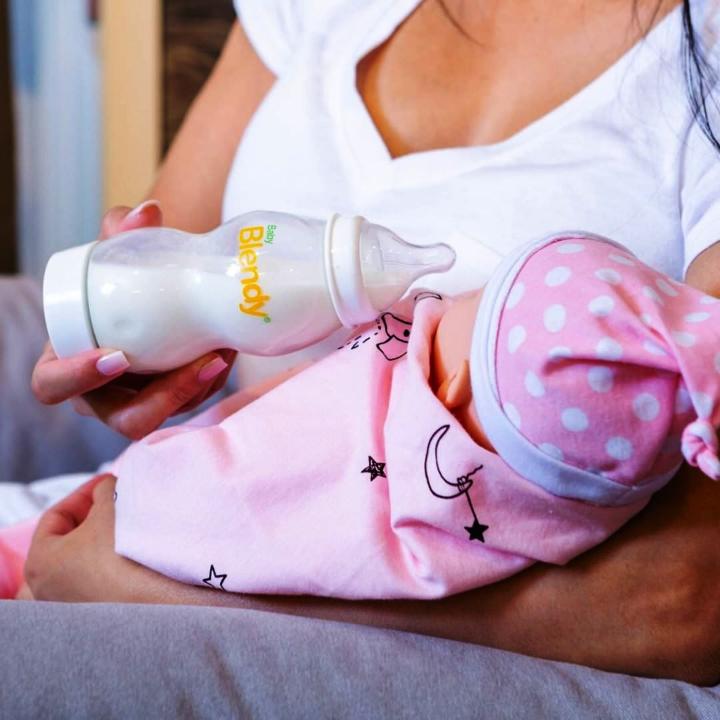Many mothers are unable to feed breastmilk to their newborns for several reasons. They may not produce enough milk, or they have to get back to work, or they simply choose not to. That’s why baby formulas are their go-to solution for keeping their baby well-fed and healthy. Let’s find out all about baby formulas and the right one for your child.
What is Baby Formula?
When new mothers can’t breastfeed their children, baby formula is used instead. Baby formulas use cow or goat milk with the high protein removed to suit the sensitive digestive system of the infant. Vitamins, minerals, and essential fats are added to the milk and made into a baby formula to ensure the baby gets all the nutrients.

Forms of Baby Formula
You can get three forms of the baby formula:
- Powder that needs to be mixed with water in one scoop to two ounces of water. This is the cheapest form of baby formula.
- Concentrated liquid baby formula is mixed with water in a 1:1 ratio. These are more expensive than the powder form.
- Lastly, the ready-to-use baby formulas are the priciest ones and need no mixing with water, and can be fed to the baby directly.
Types of Baby Formula
A wide range of baby formulas are available and they differ in their base and ingredients.
1. Milk-Based Infant Formula
These have the base of cow milk and are ideal for babies who completed their full-term and are healthy. These are fortified with iron and other minerals and vitamins as well as vegetable oils to resemble the fat composition of cow milk.
2. Organic Baby Formula
The organic baby formula uses ingredients that have been grown without the use of chemical pesticides, GMOs, additives, and preservatives. If based on animal milk, organic baby formulas contain milk from goats or cows that have not been fed hormones and antibiotics.
3. Soy-Based Baby Formula
Some babies are lactose-intolerant and can’t digest natural milk. Others may be allergic to milk proteins. For them, soy-based infant formula is the answer to their nutritional needs.
Besides the soy base, such baby formulas contain sucrose or corn syrup as a source of carbohydrates and vegetable oils to match animal milk fat. Sometimes these are iron-fortified.
Soy-based infant formulas are not recommended for underweight babies or those babies born prematurely.
4. Specialty Infant Formula
For babies with health conditions like spitting up, colic, or reflux, specialty formulas are made with their special nutritional needs in mind. The following are examples of specialty baby formulas.
- DHA and ARA omega fatty acids are derived from algae and added to specialty formulas to help develop the vision and brain of babies.
- Pre-digested or hydrolyzed proteins make the base of some specialty infant formulas. These are targeted at infants who can’t digest milk proteins or are allergic to them.
- To keep the baby’s intestines healthy and encourage the growth of good bacteria in the gut, some baby formulas contain prebiotics and probiotics.
- Some baby formulas have a high content of thickeners to keep them from having reflux.
- Many babies are underweight and need specially fortified infant formulas to supplement their nutritional needs.

How to Choose the Right Baby Formula
To choose the right baby formula, you can:
- Ask your baby’s pediatrician to guide you according to your child’s health conditions and weight.
- Try different samples of baby formula that the hospital provides you when you go home with your newborn.
Just remember to check the expiration date of the baby formula. Also, different brands have different sizes of the scoop and therefore, all baby formulas don’t have the same water to powder ratio.
Avoid buying damaged baby formula cans. Whichever brand of baby formula you buy, you can rest assured all of them are safe as they have to meet the strict criteria set by the FDA.
When to Switch Baby Formula
Diarrhea, fatigue, itchy skin, vomiting, or extreme irritation in your baby means you need to change the baby formula. But before you reach for a new brand, have a chat with your infant’s pediatrician.
There could be other reasons your baby is experiencing physical discomfort. Changing formula could make matters worse and therefore, a pediatrician should always be consulted.
Most baby formulas have a change of ingredients targeted at babies 4 to 12 months old. These follow-up formulas should be given only after the pediatrician has given the go-ahead.
How Safe Are Baby Formulas?
In the USA, baby formulas are absolutely safe to be given to babies. Strict production and nutritional guidelines are followed and certified by the FDA before the brands can make their way to the supermarket shelves.
Tips to Use Baby Formula
When you bottle-feed your baby with infant formula, there are some areas that you must pay close attention to. Read through these tips to make the feeding process for your baby safe and clean.
Top Tips for Feeding
- Newborns feed every 2 to 3 hours and the usual amount of formula they take is 2 or 3 ounces. With a tiny stomach, they can take only so much without upsetting their digestive system.
Don’t force babies to finish a whole bottle. Let them drink as much as they want. Some babies may want a bit more and that’s alright too as long as it’s within a limit.
- To save on baby formula, some mothers thin the formula by mixing more than the recommended amount of water. This has serious consequences as the baby may get too much water in its system. It can lead to electrolyte imbalances and even cerebral seizures. Plus, watering down the formula means your baby is not getting proper nutrition. This could make your baby malnourished and underweight.
- Carefully read the label of the baby formula and mix the required amount of water to the powder or liquid concentrate form. Too little water can cause diarrhea, leading to dehydration.
- You shouldn’t feed your baby who’s less than a year old with cow’s milk. It’s difficult to digest the proteins found in cow’s milk. That’s why the proteins of cow milk-based formulas have been processed to make them more easily digestible.
- If your 1-year old baby enjoys drinking cow milk, you can safely feed it to them as long as it’s the full-fat form, not skim milk or zero-fat milk.
- Some new mothers try to feed the whole bottle of baby formula to their child in one go. This might overwhelm the child, making it spit-up. To prevent this, feed slowly, keeping some time between gulps.
It’s also advised to hold the baby upright just after being fed and not to play with your child immediately after you’ve fed it.

Top Feeding Safety Tips
- You can choose a generic infant formula if the branded ones fall outside your budget. In the USA and other developed countries where stringent guidelines are followed by a national body, both generic and brand baby formulas adhere to the same criteria.
- Before preparing a bottle of baby formula for your child, wash your hands thoroughly with soap and water.
- To sterilize the bottle, nipple, and bottle cap, put them in boiling water for five minutes. Don’t worry if you notice any change in the color of the nipple. It’s perfectly usable. After 5 minutes, wash these in warm soapy water and rinse thoroughly. Use a brush to clean the recesses of the nipple and cap properly. Or, you can put them in the dishwasher too.
- To mix a powder or liquid concentrate form of baby formula, use tap water only if it’s safe for drinking. Otherwise use bottled water or boil water and let it cool before mixing with the baby formula.
- Always check the temperature of the baby formula by putting a few drops on your wrist to make sure it’s not too hot.
- Never heat the baby formula in a microwave oven. It doesn’t heat the formula uniformly, leaving some parts hotter than others. Instead, run hot tap water and put the bottle with baby formula under it to warm it.
- Or, you can warm a bowl of water in the microwave oven and keep the bottle in the bowl to warm the food. There are electric bottle warmers available with a timer that lets you heat up the formula without any hassle.
- If your baby hasn’t finished the whole bottle of formula, you can refrigerate it. Please read the label on the infant formula packaging to know how long prepared formula can be kept in the fridge.
- Usually, you must use the prepared formula of the powder form within 24 hours. If you’re using a liquid concentrate or ready-to-drink baby formula, you can probably refrigerate it for 48 hours.
Conclusion
It’s not rocket science to pick a baby formula for your child or feed it safely. Just paying attention to what your child’s pediatrician recommends along with any special health issues your child may have, you can choose the baby formula that’s best for them. With a wide range of specialty and normal baby formulas available, you won’t have much trouble bagging the right one.




